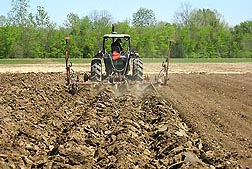Determining the Best Season for Applying Chicken Litter in the South
Mississippi farmers are increasingly using poultry litter to fertilize fields because the nitrogen in the litter boosts yields, and it cuts back on fertilizer costs. It is a particularly welcome trend in many southern states, where most of the U.S. broiler chickens—and litter—are produced.
Many farmers apply litter in the fall rather than at spring planting, because they are usually not as busy in the fall and because the litter is cheaper then, says Haile Tewolde, an Agricultural Research Service agronomist in the Genetics and Precision Agriculture Research Unit in Mississippi State, Mississippi.
Tewolde wanted to determine whether litter applied in the fall loses its potency by the following spring. Previous studies showed that in the Midwest, fall-applied litter is just as effective as spring-applied litter. But Tewolde suspected that results could be different in the South and Southeast, where warmer temperatures could make the nitrogen in the litter dissipate more quickly.
Tewolde and his colleagues applied poultry litter in the spring and fall to experimental plots of corn planted each April for 3 years. They applied the litter at two rates: 4 tons per acre and 8 tons per acre. They incorporated it into the soil by “disking,” a process that turns the soil and pulverizes it so that the litter will blend in with it. For comparison, the researchers applied nitrogen fertilizer to other test plots in the spring and fall.
The results showed that litter applications produced less corn than fertilizer applications in the first year, but those results were reversed in the second and third years. When litter was applied in the spring in the second year at the 8-ton rate, it produced 20 percent more corn than the fertilizer treatment; in the third year, it produced 9 percent more corn.
Tewolde says that in the first year, the fraction of nitrogen in the litter that became available to the crop was apparently far less than previously thought. Higher yields in the second and third years were the result of a “carryover effect,” that is, nitrogen in the litter applied the first year stayed in the soil and benefited the crop in subsequent years.
The results also showed that over the 3 years, yields were cumulatively higher in plots with litter applied in the spring than in the fall, regardless of the application rate. At the 4-ton rate, spring-application yields were 16.7 percent higher, and at the 8-ton rate, they were 12.8 percent higher. Farmers are most likely to apply litter at the 4-ton rate and apply fertilizer to supply the balance of the nitrogen the corn needs, rather than apply the full 8-ton rate, Tewolde says.
The results show that, unlike in the Midwest, the South’s warmer temperatures mean that nitrogen in fall-applied litter is more likely to volatilize into the atmosphere or leach deep into the soil, beyond the reach of plant roots, leaving less available the following spring, Tewolde says.
The study, published in 2013 in Agronomy Journal, has implications for growers who may be turned off by a single year of disappointing results with poultry litter, Tewolde says. If they stick with litter for more than a year and add some nitrogen fertilizer in that first year, their yields will improve. Yields will also be enhanced if the litter is applied in the spring rather than in the fall.—By Dennis O'Brien, Agricultural Research Service Information Staff.
This research is part of Climate Change, Soils, and Emissions, an ARS national program (#212) described at www.nps.ars.usda.gov.
Haile Tewolde is in the USDA-ARS Genetics and Precision Agriculture Research Unit, 810 Hwy. 12 East, Mississippi State, MS 39762; (662) 320-7464.
"Determining the Best Season for Applying Chicken Litter in the South" was published in the September 2014 issue of Agricultural Research magazine.







